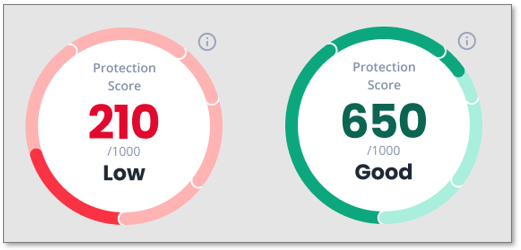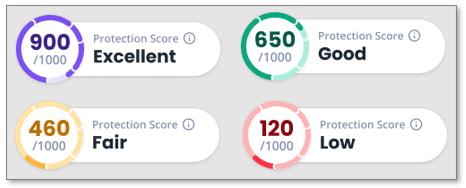The Protection Score has some similarities to a credit score where, the higher the score, the better you’re doing. So aim to keep your Protection Score as close to 1000 as you can.

To learn more, including how you can boost your score, click to expand each section:
Your score reflects how proactive you are about following our recommendations and general security ‘best practices’, with the aim of keeping your personal information safe.
If your personal information was exposed in a data breach, your score might drop. But you can improve your score and protect yourself and your identity by taking our recommended steps when presented to you.

A score over 700 is considered very good, while any score above 850 is considered excellent. This table shows a breakdown of the score ranges:
| Score Ranges | Score Status |
|---|---|
| 0–400 | Low |
| 400–600 | Fair |
| 600–700 | Good |
| 700–850 | Very Good |
| 850–1000 | Excellent |
There are many ways hackers can get their hands on your personal information, so you need to practice good digital hygiene to make sure you stay protected from threats going forward.
PII includes information that can be used to identify an individual. This information includes things such as social security numbers, telephone numbers, home addresses, or email addresses.
For example, you probably have accounts on many internet websites. These accounts might include your full name and address, your email address, telephone number, and credit card details. If one of these websites is hacked by cybercriminals, it’s seen to have experienced a data breach.
The cybercriminals could then gain access to some or all user information, and put up this breached information for sale on the dark web. PII traded on the dark web is often used for fraudulent purposes.
Which is why you must act quickly if you suspect that your own information has been involved in a data breach.
- To learn more about the dark web, see TS103098 – What is the dark web?
- To learn more about data breaches, see TS103163 – How to fix identity breaches
- You can also visit the McAfee Web Protection Center forum

